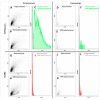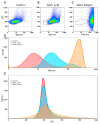Do Extracellular Vesicles Derived from Mesenchymal Stem Cells Contain Functional Mitochondria?
- PMID: 35806411
- PMCID: PMC9266972
- DOI: 10.3390/ijms23137408
Do Extracellular Vesicles Derived from Mesenchymal Stem Cells Contain Functional Mitochondria?
Abstract
Extracellular vesicles (EV) derived from stem cells have become an effective complement to the use in cell therapy of stem cells themselves, which has led to an explosion of research into the mechanisms of vesicle formation and their action. There is evidence demonstrating the presence of mitochondrial components in EV, but a definitive conclusion about whether EV contains fully functional mitochondria has not yet been made. In this study, two EV fractions derived from mesenchymal stromal stem cells (MSC) and separated by their size were examined. Flow cytometry revealed the presence of mitochondrial lipid components capable of interacting with mitochondrial dyes MitoTracker Green and 10-nonylacridine orange; however, the EV response to the probe for mitochondrial membrane potential was negative. Detailed analysis revealed components from all mitochondria compartments, including house-keeping mitochondria proteins and DNA as well as energy-related proteins such as membrane-localized proteins of complexes I, IV, and V, and soluble proteins from the Krebs cycle. When assessing the functional activity of mitochondria, high variability in oxygen consumption was noted, which was only partially attributed to mitochondrial respiratory activity. Our findings demonstrate that the EV contain all parts of mitochondria; however, their independent functionality inside EV has not been confirmed, which may be due either to the absence of necessary cofactors and/or the EV formation process and, probably the methodology of obtaining EV.
Keywords: ectosomes; exosomes; extracellular vesicles; mesenchymal stromal cells; mitochondria; stem cells.
Conflict of interest statement
The authors declare no conflict of interest.
Figures










Similar articles
-
Proteomic Analysis of Mesenchymal Stromal Cell-Derived Extracellular Vesicles and Reconstructed Membrane Particles.Int J Mol Sci. 2021 Nov 29;22(23):12935. doi: 10.3390/ijms222312935. Int J Mol Sci. 2021. PMID: 34884740 Free PMC article.
-
Intercellular transfer of mitochondrial DNA carrying metastasis-enhancing pathogenic mutations from high- to low-metastatic tumor cells and stromal cells via extracellular vesicles.BMC Mol Cell Biol. 2021 Oct 7;22(1):52. doi: 10.1186/s12860-021-00391-5. BMC Mol Cell Biol. 2021. PMID: 34615464 Free PMC article.
-
Imaging flow cytometry challenges the usefulness of classically used extracellular vesicle labeling dyes and qualifies the novel dye Exoria for the labeling of mesenchymal stromal cell-extracellular vesicle preparations.Cytotherapy. 2022 Jun;24(6):619-628. doi: 10.1016/j.jcyt.2022.02.003. Epub 2022 Mar 18. Cytotherapy. 2022. PMID: 35314115
-
Functional proteins of mesenchymal stem cell-derived extracellular vesicles.Stem Cell Res Ther. 2019 Nov 28;10(1):359. doi: 10.1186/s13287-019-1484-6. Stem Cell Res Ther. 2019. PMID: 31779700 Free PMC article. Review.
-
Therapeutic potential of mesenchymal stem/stromal cell-derived secretome and vesicles for lung injury and disease.Expert Opin Biol Ther. 2020 Feb;20(2):125-140. doi: 10.1080/14712598.2020.1689954. Epub 2019 Nov 18. Expert Opin Biol Ther. 2020. PMID: 31701782 Free PMC article. Review.
Cited by
-
A Review of the Use of Extracellular Vesicles in the Treatment of Neonatal Diseases: Current State and Problems with Translation to the Clinic.Int J Mol Sci. 2024 Mar 1;25(5):2879. doi: 10.3390/ijms25052879. Int J Mol Sci. 2024. PMID: 38474125 Free PMC article. Review.
-
Parkin characteristics and blood biomarkers of Parkinson's disease in WPBLC study.Front Aging Neurosci. 2025 Feb 26;17:1511272. doi: 10.3389/fnagi.2025.1511272. eCollection 2025. Front Aging Neurosci. 2025. PMID: 40078640 Free PMC article.
-
From Promise to Reality: Bioengineering Strategies to Enhance the Therapeutic Potential of Extracellular Vesicles.Bioengineering (Basel). 2022 Nov 10;9(11):675. doi: 10.3390/bioengineering9110675. Bioengineering (Basel). 2022. PMID: 36354586 Free PMC article. Review.
-
Bone marrow mesenchymal stromal cell-derived small extracellular vesicles: A novel therapeutic agent in ischemic heart diseases.Front Pharmacol. 2023 Jan 5;13:1098634. doi: 10.3389/fphar.2022.1098634. eCollection 2022. Front Pharmacol. 2023. PMID: 36686710 Free PMC article. Review.
-
Role of Exosomes in the Pathogenesis and Theranostic of Alzheimer's Disease and Parkinson's Disease.Int J Mol Sci. 2023 Jul 4;24(13):11054. doi: 10.3390/ijms241311054. Int J Mol Sci. 2023. PMID: 37446231 Free PMC article. Review.
References
-
- Yáñez-Mó M., Siljander P.R.-M., Andreu Z., Zavec A.B., Borràs F.E., Buzas E.I., Buzas K., Casal E., Cappello F., Carvalho J., et al. Biological Properties of Extracellular Vesicles and Their Physiological Functions. J. Extracell. Vesicles. 2015;4:27066. doi: 10.3402/jev.v4.27066. - DOI - PMC - PubMed
MeSH terms
Grants and funding
LinkOut - more resources
Full Text Sources

